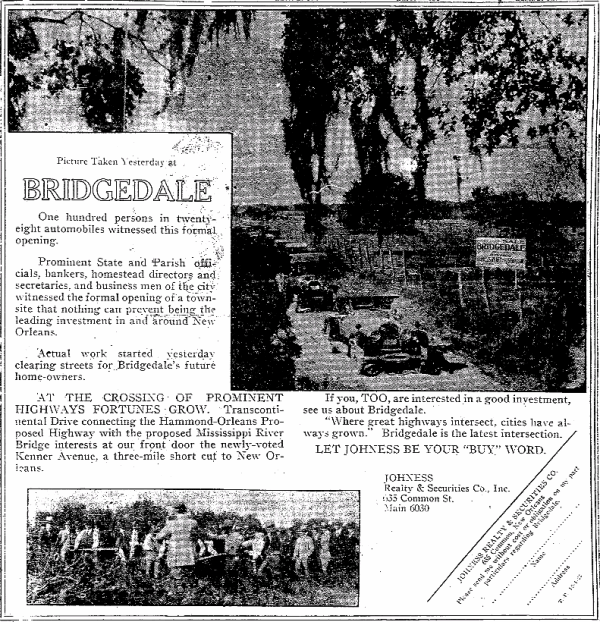|
Today in New Orleans History |
|
|
December 4


LSU's First Mike the Tiger in his Cage Mike I was nineteen
years old when this photo was taken. Mike VI now (sometimes) roars at LSU home football games. From LSU: Mike I (1936-1956) In 1934, Athletic Department trainer Chellis "Mike"
Chambers, Athletic Director T. P. Heard, Swimming Pool Manager and Intramural Swimming Coach William G. "Hickey"
Higginbotham, and LSU law student Ed Laborde decided to bring a real tiger to LSU, then known as the "Old War Skule."
They raised $750, collecting 25 cents from each student, and purchased a 200 pound, one-year-old tiger from the Little Rock
Zoo. The cub was born on Oct. 10, 1935, and was originally named Sheik. His name was changed in honor of Chambers, the man
most responsible for bringing him to LSU. Mike I arrived on campus on Oct. 21, 1936. Mike died on June 29, 1956, of complications
associated with kidney disease. Following Mike's death, a fund was established to perpetuate his memory by mounting his pelt
in a lifelike manner and displaying him at the university's Louisiana Museum of Natural History, where it remains to
this day.
     Joe Brown, born on May 18, 1926 in Baton Rouge, was the undisputed Lightweight
Championship of the World in 1956, a tiltle he held 11 times until losing to Carlos Ortiz
in 1962. Known as the ‘Creole Clouter’ and Joe ‘Old Bones’ Brown, he was managed by Lou
Viscusi and named The Ring's 'Fighter of the Year' for 1961. Brown was inducted into the International Boxing
Hall of Fame in 1996. In his later years he was a trainer in New Orleans and died in New Orleans on December 4, 1997
at age 71.
Photos taken on December 4, 1954: The Liberty ship Martin Behrman was launched at Delta Shipbuilding Company on December 4, 1944. Many photos of the Algiers Naval Station taken on December 4, 1940. On Tuesday, December 4, 1938 the Cleveland Rams beat the Pittsburg Pirates 7-0 in Municipal
Stadium (City Park Stadium) with 7,500 in attendance. This was the first regular NFL season game ever played in New Orleans.
The French Opera House burned in the early morning hours of December 4, 1919. By dawn, the building was in ruins. The cause of the fire was never determined, although it was widely believed to have begun in the restaurant housed in the building. For years, New Orleanians cherished hopes of rebuilding the theater and resurrecting the elegant days of French opera, but in the 1960s a modern hotel (now the Inn on Bourbon) was erected on the site. Until the construction of the Theater of the Performing Arts in 1973, New Orleans was without a permanent home for opera. (From the New Orleans Public Library) See Photos.
At the December 4, 1795 meeting of the Cabildo, it was agreed that the hangman could not continue living at his present abode because it is the place where Royal Ensign Don Andres Almonaster has started construction of the Capitol Houses. It was under construction from 1964 to 1968,
at a cost of $25 million. By 1994, this building was estimated to be worth $300 million. The Rivergate had pedestrian
entrances on Canal and Poydras Streets and Convention Center Boulevard. The South Peters Street elevation was dedicated
to entrance and exit openings for the two-level subsurface 800-automobile parking garage, a long loading dock with two
access doors 20' x 20' to the first floor, and freight elevators. The caption for the postcard (above) reads: The
RIVERGATE, which covers six city squares, located where famed Canal Street meets the Mississippi River, is one of the most
uniquely constructed convention-exhibition halls in the country. Boasting 130,000 square feet of clear, unobstructed space,
with no posts or pillars; it is capable of seating more than 16,000 persons for an assembly or meeting with 733 - 10'
x 10' exhibit spaces, or a combination of both. This 13 1/2 million dollar ($13,500,000) structure will be one of the
nation's newest and finest facilities". Ground breaking ceremonies on December 4, 1964
were followed by the driving of piles and a deep excavation to provide space for the parking garage, mechanical and electrical
equipment, stairs and escalators to move people from subsurface levels up to the first floor, and the tunnel 60' x
750' ($1.3 million). Although the Rivergate was conceived and designed as a convention-exhibition facility, it
was also used as the venue for Mardi Gras balls, high school graduations, and the lying in state of New Orleans native
Mahalia Jackson in 1972). But like the Municipal Auditorium, the Rivergate became obsolete in its usefulness as a convention
and exhibition center. The Ernest N. Morial Convention Center was being planned in 1978. As of 2006, it
has about 1.1 million square feet of exhibit space, covering almost 11 blocks, and over 3 million square feet of total space.
It is the 5th-largest facility of its kind in the United States and would dwarf the old Rivergate. The
City of New Orleans then altered the zoning ordinances to allow construction of a casino at the Rivergate site.
The city issued a call for casino proposals due on August 14, 1992 which required a $50,000 payment
for the privilege of submitting a proposal, half of which was refundable to unsuccessful bidders. On November
5, 1992, Mayor Sidney Barthelemy and the City Council picked Christopher Hemmeter-Caesar's Palace (known as
the Grand Palais group) to lease the city-owned Rivergate site for development of a casino. The lease was signed
on April 27, 1993. Subsequently, the Casino Board awarded the casino operator's license to Harrah's Jazz, a partnership
of Harrah's and the Jazzville group (all local investors). On April 15, 1993, Mayor Barthelemy
and the City Council finalized the selection of Hemmeter as the "developer" -- he later teamed with Caesar's
World of Las Vegas to operate the casino in a renovated Rivergate but soon the Hemmeter-Caesar's group proposed its demolishion
to make way for a new building called Grand Palais. This plan would include a twenty-two-inch deep pond, called
Celebration Lake which would run across the foot of Canal Street, ending at One Canal Place. And there would be a sound
and laser-light show and much more including a recreation of Bernard the colonnaded arcades at the Palace of Fine Arts in
San Francisco. In the end, the only elements of the Grand Palais scheme that were constructed were the "Casino
Support Facility" -- a ten-leve, 2 1/2 block long parking garage) which replaced a group of nineteenth-century buildings
at the corner of Poydras and South Peters Streets and the tunnel linking it to the casino. But everything else fell
through. The official "wall-breaking" ceremony took place on Friday, January 13, 1995.
On this occasion, a back hoe equipped with a claw toothed bucket and a "Harrah's" banner draped on its back
climbed up the steps at the Canal-South Peters Streets entrance and began wrecking the underside of the cement plaster
entrance canopy. Much of the concrete debris was hauled to West End at Lake Pontchartrain to be used as fill for
enlargement of a park off Breakwater Drive. Although only reinforced concrete was supposed to be dumped there, other
debris was included. The nature of the debris stirred environmentalists and their protests stopped the dumping at the
West End site. On October 28, 1999, Harrah's Casino was completed at the foot of Canal Street,
three years behind schedule. From THE RIVERGATE (1968 - 1995) Architecture And Politics -- No Strangers In Pair-A-Dice
|
|
|

To receive an update for each day in New Orleans history,
join our facebook page - Today in New
Orleans History.
Analytics |

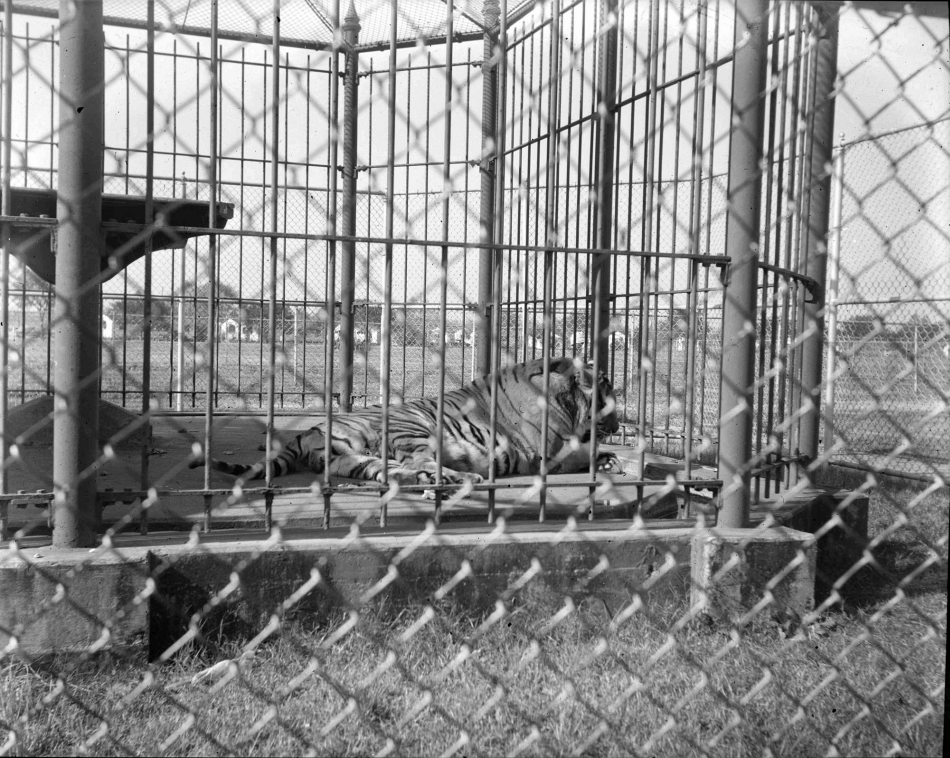

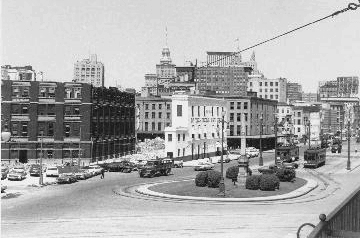
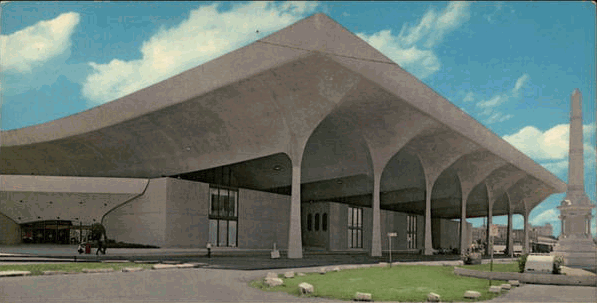 The Rivergate was designed by the local firm Curtis and Davis (Nathaniel Cortlandt Curtis Jr. (1917–1997) and Arthur
Quentin Davis (1920–2011) who had also designed the Thomy Lafon School (1954) and the Louisiana State Penitentiary
at Angola (1956) and would later design the Superdome. The undulating forms of the Rivergate's thin barrel
vaults were not whimsical but are the precise shape necessary to manage the unusually long spans required for the roof
over the column free space below. The cantilevers all around contribute to the stability of the roof structure. The selection
of six temple like bays utilized to the limit the spans between columns; the columns themselves are slender and graceful,
suited to the task of support. The Rivergate, while it stood in New Orleans, was looked upon by many as a significant
example of outstanding national and international contemporary architecture and was compared to the recognized masterpieces
of its period. The most distinguishing feature of the Rivergate was the roof. The 95,500-sq. foot South Hall
was covered by a swooping and sweeping dual curved roof. This reinforced concrete barrel-arched roof design was symbolic
of the rolling Mississippi River which flows about 500 feet from the building. Engineering News Record referred to
these "humpbacked" 1-1/2 catenary curve barrel arches 453 ft. long as having the profile of a whale. The Rivergate
roof was perhaps the longest thin shell concrete roof span that had been constructed at that time. The 34,500-sq. foot
North Hall, later called Penn Hall, in honor of its distinguished and successful manager, Herman Penn, was spanned
by steel trusses 6' deep and covered with a flat roof.
The Rivergate was designed by the local firm Curtis and Davis (Nathaniel Cortlandt Curtis Jr. (1917–1997) and Arthur
Quentin Davis (1920–2011) who had also designed the Thomy Lafon School (1954) and the Louisiana State Penitentiary
at Angola (1956) and would later design the Superdome. The undulating forms of the Rivergate's thin barrel
vaults were not whimsical but are the precise shape necessary to manage the unusually long spans required for the roof
over the column free space below. The cantilevers all around contribute to the stability of the roof structure. The selection
of six temple like bays utilized to the limit the spans between columns; the columns themselves are slender and graceful,
suited to the task of support. The Rivergate, while it stood in New Orleans, was looked upon by many as a significant
example of outstanding national and international contemporary architecture and was compared to the recognized masterpieces
of its period. The most distinguishing feature of the Rivergate was the roof. The 95,500-sq. foot South Hall
was covered by a swooping and sweeping dual curved roof. This reinforced concrete barrel-arched roof design was symbolic
of the rolling Mississippi River which flows about 500 feet from the building. Engineering News Record referred to
these "humpbacked" 1-1/2 catenary curve barrel arches 453 ft. long as having the profile of a whale. The Rivergate
roof was perhaps the longest thin shell concrete roof span that had been constructed at that time. The 34,500-sq. foot
North Hall, later called Penn Hall, in honor of its distinguished and successful manager, Herman Penn, was spanned
by steel trusses 6' deep and covered with a flat roof. 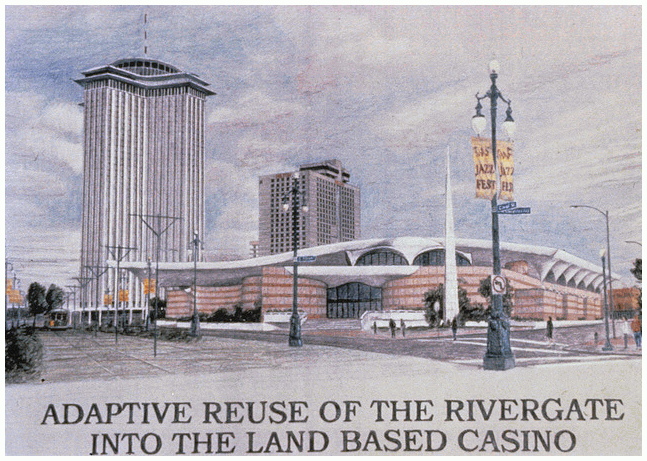 In June 1992, Louisiana House Bill 2010 (Act 384 of the 1992 Regular Session) authorized a land-based casino in New Orleans.
The legislation specifically defined the location of the land-based casino -- the Rivergate site at the foot of Canal
Street. The law did not require the Rivergate to be torn down, and it did not require a new casino to be built.
In June 1992, Louisiana House Bill 2010 (Act 384 of the 1992 Regular Session) authorized a land-based casino in New Orleans.
The legislation specifically defined the location of the land-based casino -- the Rivergate site at the foot of Canal
Street. The law did not require the Rivergate to be torn down, and it did not require a new casino to be built.